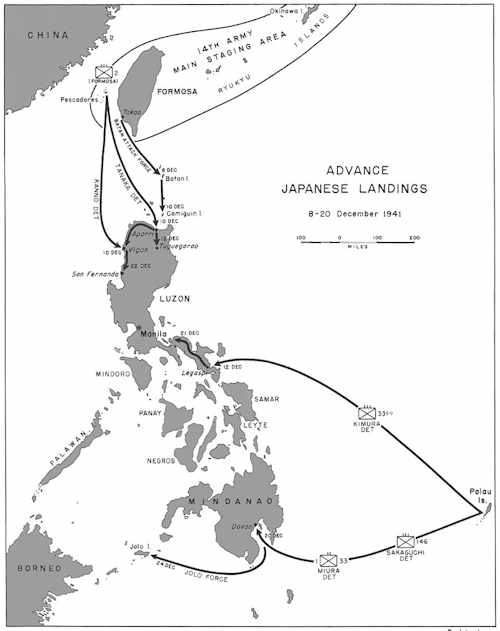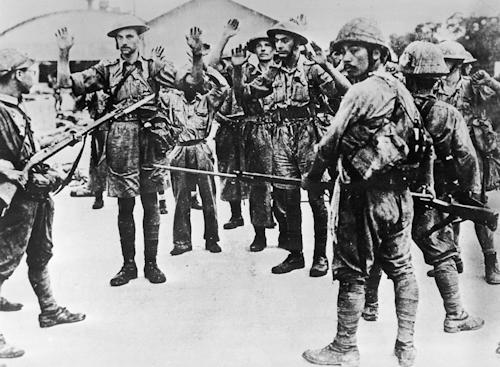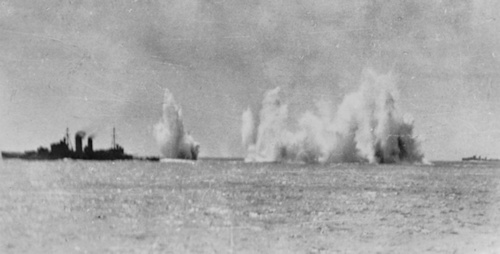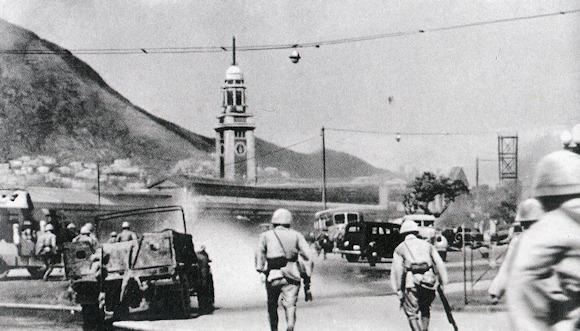After the successful attack on Pearl Harbor, Japan had to continue and pursue its objectives, which included all those essential resources (oil, rubber, tin, etc.) which, once obtained, would have guaranteed the possibility of continuing the war against the United States. However, the raw materials needed by Japanese heavy industries were, for the most part, in territories belonging to the traditional European colonial powers: France, Holland and the United Kingdom.
On December 7, 1941, while the aircraft carriers that had participated in the attack on Pearl Harbor were still on their way back, massive Japanese convoys, loaded with men and weapons, headed towards the Philippines, Borneo, Sumatra, and Malaya. .
The attack launched by the Japanese in the Pacific Ocean and the Indian Ocean simultaneously hit enemy bases from Wake and Guam, to the Philippines, Hong Kong (opening photo) to Singapore, from Burma to Borneo, creating overnight a land and naval front of immense proportions.
The Imperial Navy was, in 1941, the third largest fleet in the world. His ships, which came out of the Yokoama and Kobe shipyards, were almost all of very modern design. In addition to a fleet of battleships of 10 units, the Japanese deployed 13 aircraft carriers, 5 of which were very recently built, 40 cruisers and an impressive number of smaller units. There were 73 submarines. The rest of the fleet either kept watch in home waters or escorted the numerous convoys carrying the invasion forces.
 When the Japanese launched an offensive in all directions, occupying the main enemy bases one after another, the world was astonished. The air-naval superiority was reaffirmed by the double blow inflicted on the British Navy with the sinking of only two battleships, Prince of Wales e Repulse, which Churchill had been able to transfer to the Pacific; it became clear that no one, for a long time, would be able to effectively oppose the Japanese offensive thrust.
When the Japanese launched an offensive in all directions, occupying the main enemy bases one after another, the world was astonished. The air-naval superiority was reaffirmed by the double blow inflicted on the British Navy with the sinking of only two battleships, Prince of Wales e Repulse, which Churchill had been able to transfer to the Pacific; it became clear that no one, for a long time, would be able to effectively oppose the Japanese offensive thrust.
The Japanese industry, although enormously developed in recent years, would not, in fact, have been able to maintain the pace required by war needs if it had not been able to draw not only from the Manchurian and Chinese resources, but also from the very considerable deposits of minerals of all kinds which are rich in the large Sunda islands, Burma, Indochina and Thailand.
The landings in Borneo, in addition to the conquest of the oil wells of the large island, were essential to organize the investment of Java, Sumatra and Timor, as well as the Celebes.
In Malaya, in their rapid march on Singapore, the Japanese aimed to inflict another very serious loss on the enemy. In fact, with the possession of Singapore and the entire Malay peninsula, the Japanese command would have practically prevented the enemy from operating in the waters of Sunda and in the Indochina Gulf, making it possible, at the same time, to send its ships and submarines on the routes for India.
The effort supported by the Japanese war fleet and merchant navy in the first days of the war was impressive. Over half a million men, with a gigantic array of war vehicles and supplies, were transported in the most diverse directions and happily landed on enemy territory. And it wasn't a question of crossing short stretches of sea, but of traveling two thousand or more miles, often in waters controlled by enemy ships, submarines, planes, always with the threat of hurricanes, which are particularly frequent in the Sunda and South Seas. Malaysia.
The landing troops, chosen from among the best available, had had extensive training in amphibious warfare and had special boats at their disposal, designed to make them easy to use on the shallow waters of the Pacific islands.

For the invasion of Malaya, the Japanese had for several weeks amassed a considerable force in French Indochina, estimated at around one hundred thousand men, the majority of which had been deployed in the southern part, leading to the prediction of a further push towards the south, i.e. direction of the Malacca peninsula.
Transit operations in Thailand proceeded quickly. The Siamese army offered only symbolic resistance to the Japanese troops, thus creating the conditions for a real political and military alliance.
A fundamental element that must not be forgotten if one wants to objectively judge the conduct of operations in Malaysia was the extreme military and moral preparation of the troops of the Rising Sun. The soldiers who landed in Kota Bharu, Patani and Singora, in the north of the Gulf of Malaya, were not young conscripts, as on the contrary happened among the British. The Japanese came directly from the Shanghai and Canton regions of China. They had faced a legendary crossing, crammed into the holds of cargo ships. Tempered by the iron discipline of their superiors united in a spirit of military brotherhood, which has probably never been equaled again.
The officers were no different. They struggle to carry their sword, recalling the tradition of the samurai, alongside the modern revolver. They had no privileges over the troops and shared their hardships and deprivations.

Simultaneously with the Philippine investment, the Japanese made numerous surprise landings on two other large islands: the Celebes and Borneo. In Borneo, especially in the northern part belonging to Great Britain, the Japanese aimed above all at control of the oil plants. The Celebes, however, were considered as a base for further offensive actions towards New Guinea and Australia.
Il 27 February 1942 the Battle of the Java Sea took place between a Japanese naval force commanded by Admiral Takeo Takagi (1892-1944), later killed in action during the Battle of Saipan in 1944, composed of 2 cruisers armed with 10 203 mm guns, and a multinational team ABDA (America, Great Britain, Holland and Australia) under the command of the Dutch admiral Doorman (1889-1942), composed of 5 cruisers and 9 fighters.
The Japanese team had the task of protecting the convoy carrying the troops destined to invade and occupy Java, the ABDA team had the task of preventing the landing. The tactical action was mastered by the Japanese team due to its superior speed. This battle was a typical example of perfect cooperation between cruisers and fighters.
The fire was opened at a distance of 24.000 meters, but the Japanese at 16.000 meters launched their fighters in a torpedo attack. The torpedoes crossed the Allied formation which was forced to maneuver to avoid them. A torpedo hit the Dutch fighter Kortenaer which sank quickly.

Meanwhile the British cruiser Exeter (following photo), damaged by the artillery with a hit in the boilers, went out of formation and retreated towards the Sarabaia base. After three hours of fighting the British fighter was sunk Electra. All Allied ships had been hit and could only proceed at reduced speed. At sunset the Dutch admiral disengaged, protecting his retreat by launching fighters against the Japanese ships. During the night the English fighter was sunk Jupiter hit by a torpedo without realizing which way it had come; the Dutch cruisers Java e Ruyter they were torpedoed and sunk. The other units that tried to escape towards Ceylon were attacked and destroyed, Admiral Doorman was among the fallen.
The island of Java, defended by 70.000 Dutch soldiers and 15.000 Americans and British, surrendered on March 9th.
The dead of the campaigns of conquest of Japan, according to Shinto myth, were all welcomed to Yasukuni, the temple dedicated to the souls of soldiers and all those who died fighting in the emperor's service. The shrine was built in Tokyo on Kudan Hill in 1869 on the orders of Emperor Meiji (1852-1912) to commemorate the victims of the Boshin War, literally (War of the Year of the Dragon, 1868-1869) which had resulted in the defeat of the military governments (shogunate) and the restoration of the emperor at the head of the country.
Photo: web












